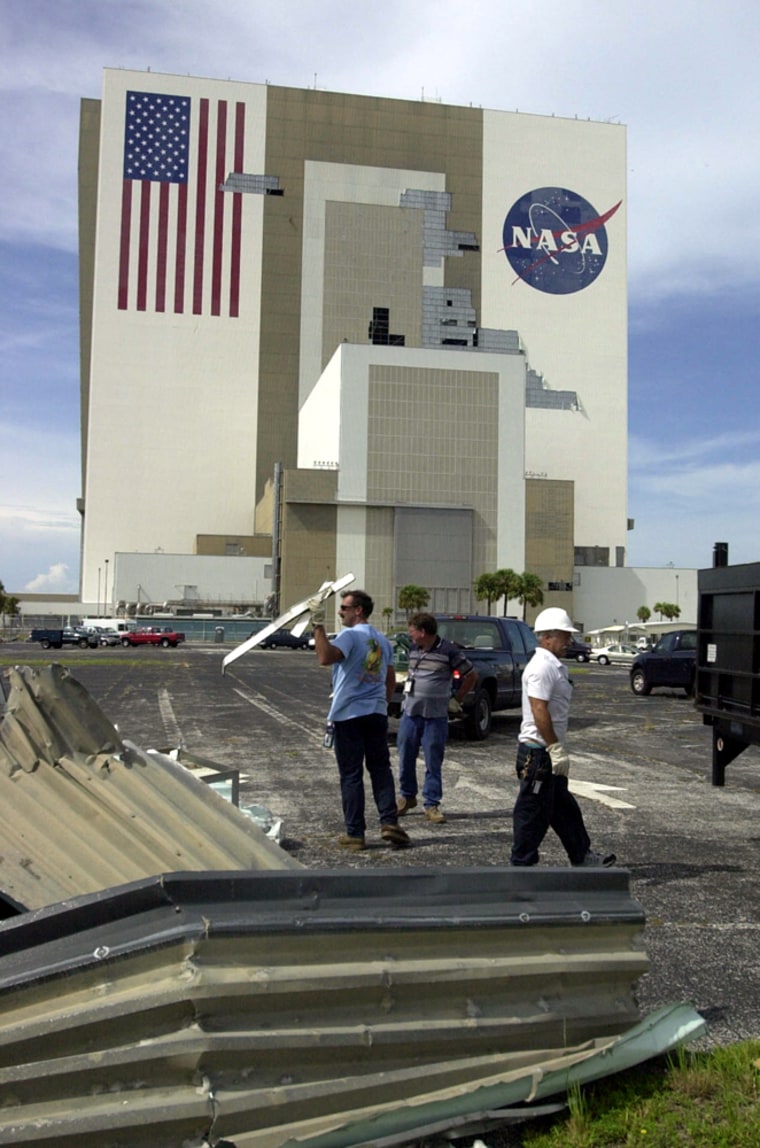The director of the hurricane-ravaged Kennedy Space Center on Tuesday refused to speculate whether the damage will thwart plans to resume shuttle flights next spring, but his words offered little hope of an on-time launch.
Fresh from a helicopter tour of the waterlogged and wind-damaged spaceport, James Kennedy said everything right now is “very much to be determined.”
“I’m not going to estimate when we might return to flight,” he said. “We’ll be working with the shuttle program people over the coming weeks to help assess that.”
NASA’s shuttle fleet has been grounded since last year’s Columbia disaster, and the agency hopes to return to flight in March or April with the launch of Discovery.
Buildings damaged, but not shuttles
No shuttles were damaged in any way when Hurricane Frances hit over the weekend. But three critical shuttle buildings sustained heavy damage, with the most destruction at the mammoth assembly building where space shuttles are attached to their booster rockets and external fuel tanks.
Also damaged were the shop where shuttle thermal tiles are made from scratch, and the building that serves as the hub for shuttle computer software.
“While it is so much better than we thought it might have been, the truth of the matter is many, many buildings have siding and roofing damage, water-leaking situations, and there’s going to be an awful lot of work to repair the damage that’s been done,” Kennedy said.
No one was on site when Frances struck late Saturday, with sustained wind that topped 70 mph (112 kilometers per hour) and lasted 30 hours. Kennedy had evacuated the entire center the previous Thursday, for the first time ever.
‘Open window to the world’
The latest count had 820 exterior panels missing from the 52-story Vehicle Assembly Building. About a quarter of the panels were punched all the way through — “an open window to the world,” as Kennedy called it.
Each aluminum panel is 4 feet by 16 feet (1.2 by 4.8 meters), making for 52,480 square feet (4,723 square meters) of damage.
Most of the panels were missing from a wall that bears giant images of the round blue NASA logo and the U.S. flag. Parts of two red stripes and one white stripe were carved away. Journalists on an escorted tour could see lights inside the building, through the gaping holes.
Even more worrisome was the fact that the roof of the 1960s building sustained major damage. Thirty workers had just made it to the top for an inspection Tuesday, when they decided it was too dangerous and quickly got off.
“It was soggy. It was weak and they did not want to run the risk of falling through the roof,” Kennedy said.
How to fix the holes
Kennedy said he has no idea how NASA will fix the roof or the holes from the panels. The windshields of NASA vehicles parked outside the building were shattered by the panels, which Kennedy described as flying shrapnel.
Kennedy called the Vehicle Assembly Building priceless; it was built to accommodate the Saturn 5 rockets that carried men to the moon.
He assured reporters that the structure would be restored to a safe condition.
For now, netting is being hung inside the Vehicle Assembly Building to catch any debris blowing through the holes. Kennedy said that is the best that can be done in advance of Hurricane Ivan, which could reach Florida as early as Saturday.
Kennedy said the space center will remain closed until Monday to most of its 14,000 workers.
